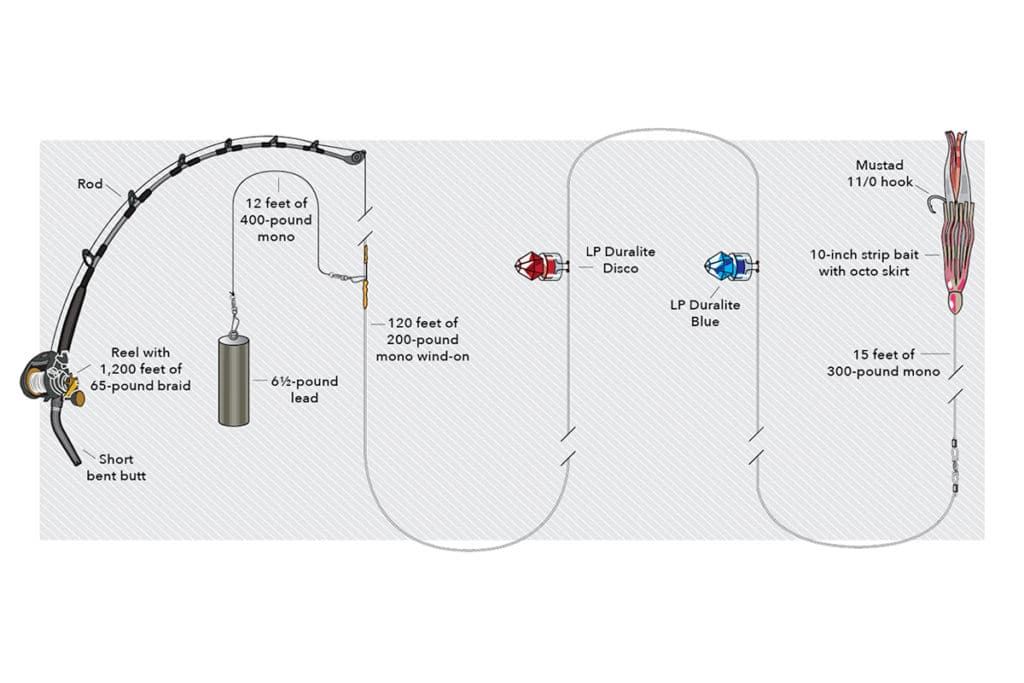Tales of Daytime Swordfish and Deep Tuna
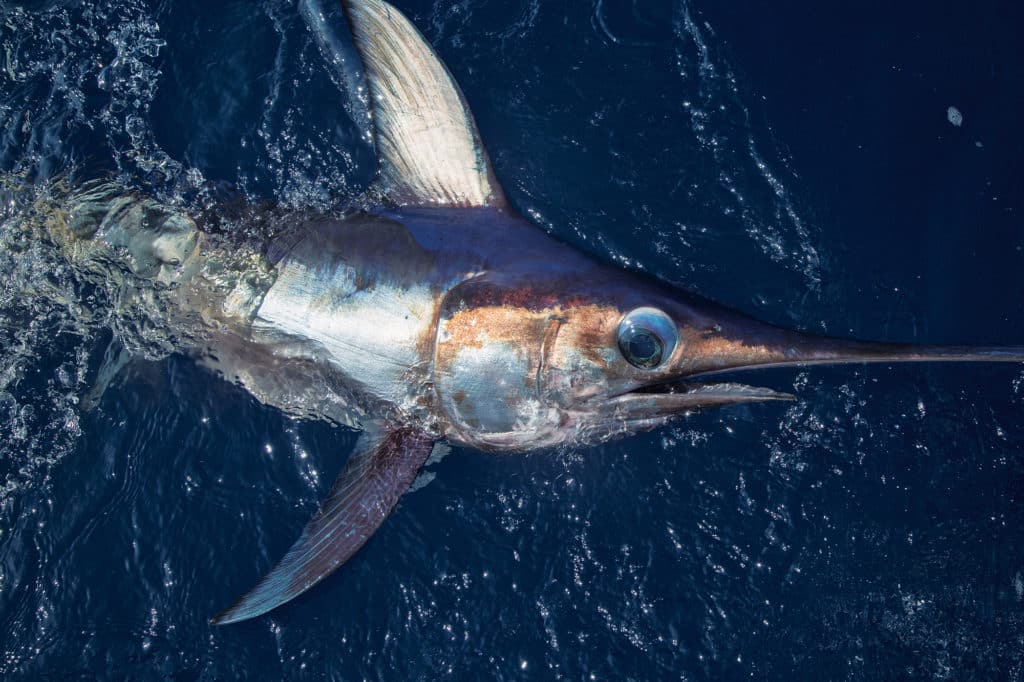
A century ago, when millionaire author Zane grey wasn’t writing westerns for books and movies, he was searching for swordfish, marlin and tuna off California’s Santa Catalina Island. The technique he pioneered — sighting sunning swordfish and trolling baits past them — defined swordfish angling until the 1970s. But when expanding longliner fleets showed that more swords hung near the surface at night, daytime swordfishing gave way to drifting for swords in darkness.
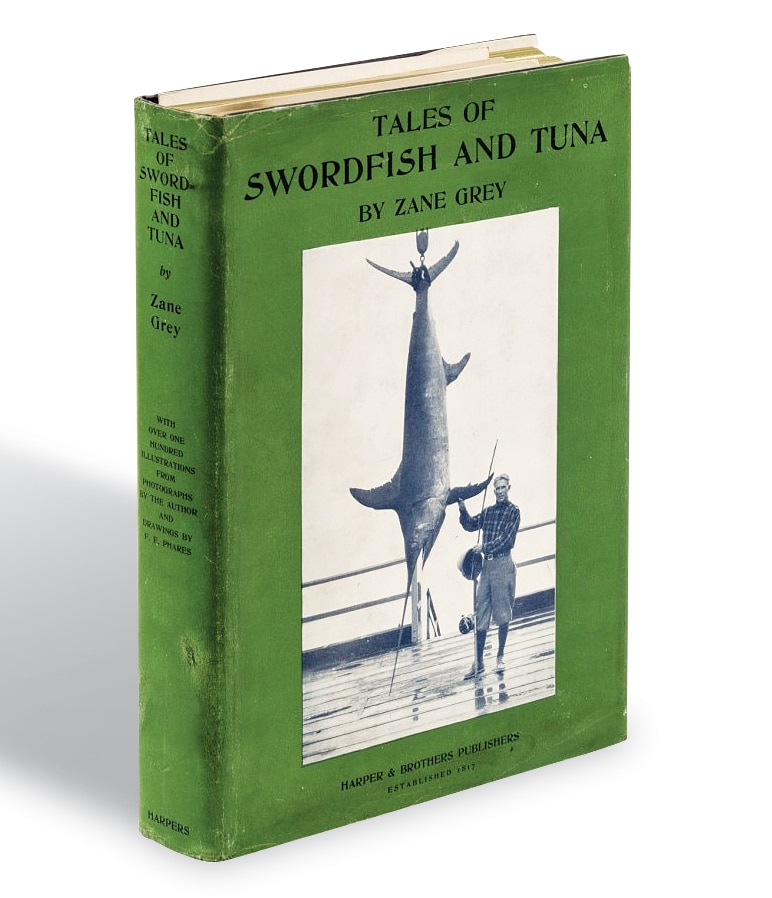
A decade ago this September, swordfishing re-entered the light when fisherman and artist Capt. R.J. Boyle, of South Florida, pulled a 270-pound swordfish up 1,350 feet from the bottom in broad daylight. Like Grey, Boyle freely shared his technique. Today, variations of Boyle’s rig pull swords up from the abyss in every state from Massachusetts through Texas, down into the Caribbean, and as far away as the Red Sea. Dropping baits a quarter-mile beneath their boats, those anglers aren’t catching just broadbills, either. Tuna, marlin and sailfish are biting swordfish baits at surprising depths. I asked five pioneers of daytime swordfishing to share their methods as well as knowledge about the pelagic species they’re bringing up from deep water.
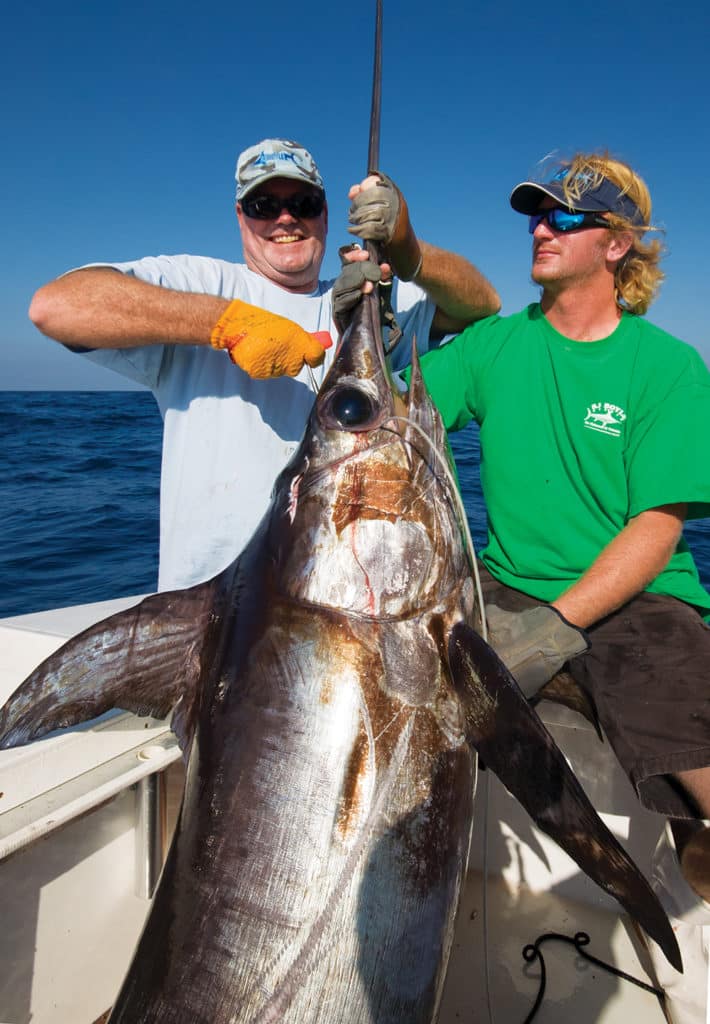
“That first fish jumped like a maniac,” Boyle says. “You think you see the colors and the power of swordfish at night, but once I fought one in daylight, I thought, I’m never night fishing again.” Grey would have agreed. Holding simultaneous records for a 758-pound bluefin tuna, 318-pound yellowfin tuna and 582-pound broadbill swordfish, Grey claimed swordfish were “the supreme test of an angler” in his 1927 classic Tales of Swordfish and Tuna.
Yet while Grey struggled to locate surface fish, Boyle’s challenge was getting baits down 1,700 feet in 3.5 knots of current. He finally settled on a 12- to 15-pound stick lead secured 150 feet from the bait, fished on 65-pound braid on a Lindgren-Pitman S-1200 reel. Once on the bottom, Boyle drives south, into the 3.5-knot current, at about 2 knots. His goal is a 1.5-knot northward troll.
Grey’s bigger problem, a century ago, was enticing the bite. He claimed only one in 12 sunning swordfish were eager enough to hook.
“I was getting bites every drop,” Boyle says, “but I was going one for 20. I couldn’t keep hooks in the fish.” The secret, it turns out, is strike drag. Boyle settled on 25 pounds pulled for 10 seconds after the rod fully loads. “With a 12-pound lead and resistance from 2,500 feet of line in the water, it takes 15 to 17 pounds of drag at the reel just to move the bait,” Boyle explains, which leaves just 8 pounds of pull to set hooks. By increasing drag, he raised his numbers to one caught fish in five bites, and now Boyle boats more than six of every 10 strikes.
Spreading the Technique
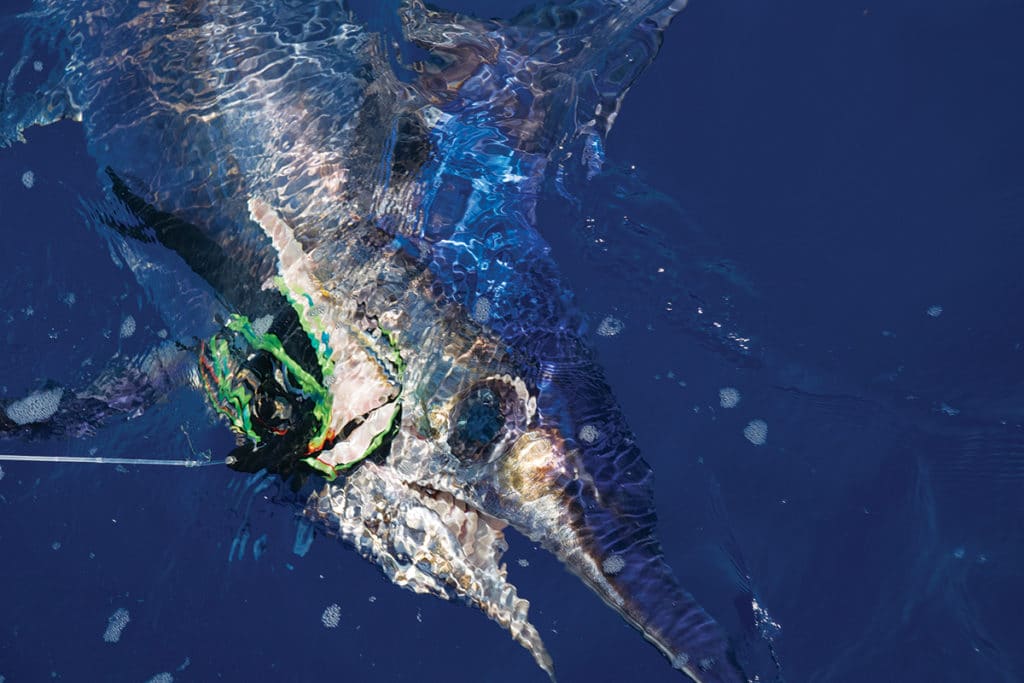
The crew of the 52-foot Viking Booby Trap fished with Boyle in Fort Lauderdale in 2010. After catching more than 20 swords, including one more than 500 pounds, the crew thought, “OK, we’re ready to go back to Texas with this,” says Jeff Wilson, the boat’s skipper at the time. This marked the first test of Boyle’s rig in light currents, with a 1-knot drift in the northern Gulf of Mexico, as opposed to the 3.5-knot Gulf Stream current. “On our first drop, we had the biggest tangle you have ever seen,” says Wilson. Then he surpassed that massive tangle on his second drop.
These days, Wilson uses a 7-pound sacrificial weight attached right to the baited hook, rigged to break away immediately at the bottom, plus an additional 3-pound weight 60 feet from the hook to hold the leader down while fishing. “When I mark bait schools and individual fish on the bottom, I can drop that rig right on the swordfish,” Wilson says, and he entices double-headers by dropping a second baited rig after one fish is hooked.
Using just 3 pounds of lead also makes it practical to use conventional 50-wides loaded with braid. “If fishing is slow, we switch to the electric reel and bump-troll at 2 to 4 knots to cover ground, and we also move the bait up and down more,” Wilson says. The only changes from how the crew rigs with manual gear are swapping the 3-pound lead for one around 7 pounds, 100 feet from the bait, and using a 10-pound sacrificial drop weight.
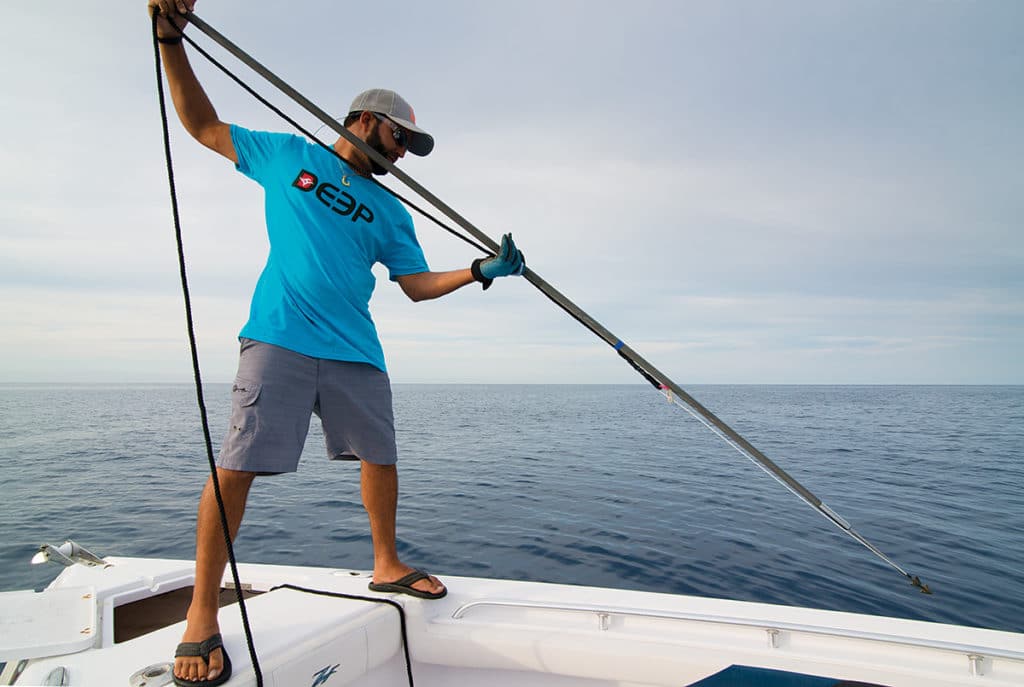
The latest emerging daytime sword fishery is in the canyons stretching from Virginia to New England. “Swordfish are traditionally a bycatch while we’re chunking for tuna at night,” says Capt. Lou DeFusco, out of Rhode Island. But in 2012, a 434-pound sword hooked at night — the current Rhode Island record — finally came alongside DeFusco’s boat past dawn. “Fighting that fish in daylight motivated me,” he says. “I watched all the videos from Booby Trap, from R.J. Boyle, from Nick Stanczyk [a daytime swordfishing pioneer]. I had clear ideas on what I needed to do for daytime swordfish in the Northeast canyons.” Building on those ideas, DeFusco has since caught more than 40 swordfish off the bottom. “This isn’t Florida. We don’t need 12 or 15 pounds of lead. I downsized everything,” he says (see “DeFusco’s Daytime Swordfish Rig“).
To reach bottom, DeFusco motors slowly into the current, lets the bait stream astern and then lowers his 6.5-pound lead until it’s 75 feet from the bottom, comparing the reel’s line counter to sonar-recorded depth. At his GPS mark, he says, “I back the boat until the line drops vertically from the rod tip, then I drop it the last few feet to the bottom and wind up 100 feet.” He lets the boat drift most days, or bump-trolls to maintain at least ¾-knot progress over the bottom. “I’m constantly winding up and dropping down, 10 feet at a time,” he says. He also periodically checks to maintain his lead 75 to 125 feet from the seafloor.
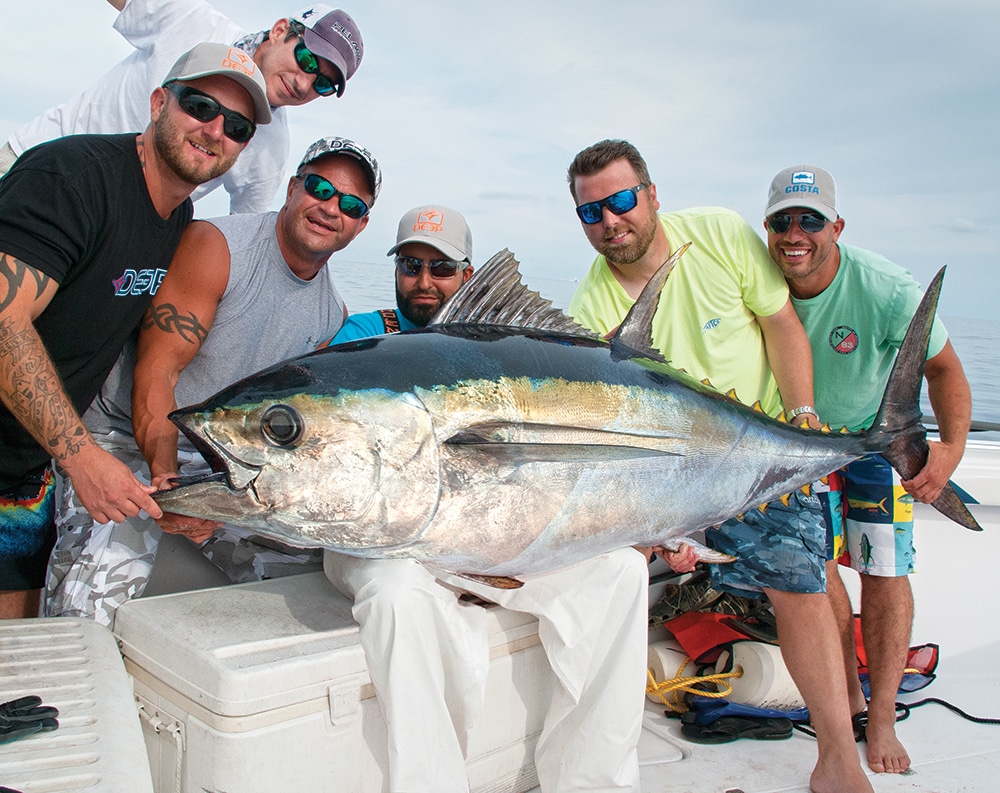
Ferocious daytime swordfish strikes are mitigated by several hundred yards of line, a heavy lead and a long drifting leader. “The rod tip falls into a rhythm with the rocking boat,” DeFusco says. “Get in tune with that, and you’ll see every bite — any bounce outside of that rhythm.” That might be a 6-inch deflection in the rod, but more often it’s light taps every 10 seconds. When he gets a strike, DeFusco lowers his lead toward the bottom. “That moves the bait a little. The sword follows it and eats it right down the hatch,” he says, which limits foul-hooked fish. “If you don’t hook up, keep moving the bait up or down.” Once he feels the fish steadily, DeFusco reels with at least 25 pounds of drag.
Larry Backman, after 15 years of fishing Northeast canyons, is currently one of a handful of captains, professional and enthusiast, who devote daylight hours to swordfishing in the canyons. He prefers 10 pounds of lead to hold bottom while bumping an engine in gear to speed his drift to between 2 and 3 knots. “We see the bites on heavier tackle. That’s never been our problem,” he says. On 11 trips in 2015, Backman logged 60 bites but brought only nine fish onto the deck, although that ratio improved late last season when he increased from 15- to 25-pound strike drag. “Let the fish eat. When you believe you have it hooked, get the slack out and either pull the hook or not,” he says. He believes his 80-class rod and the LP S-1200’s extra cranking power aid that process.
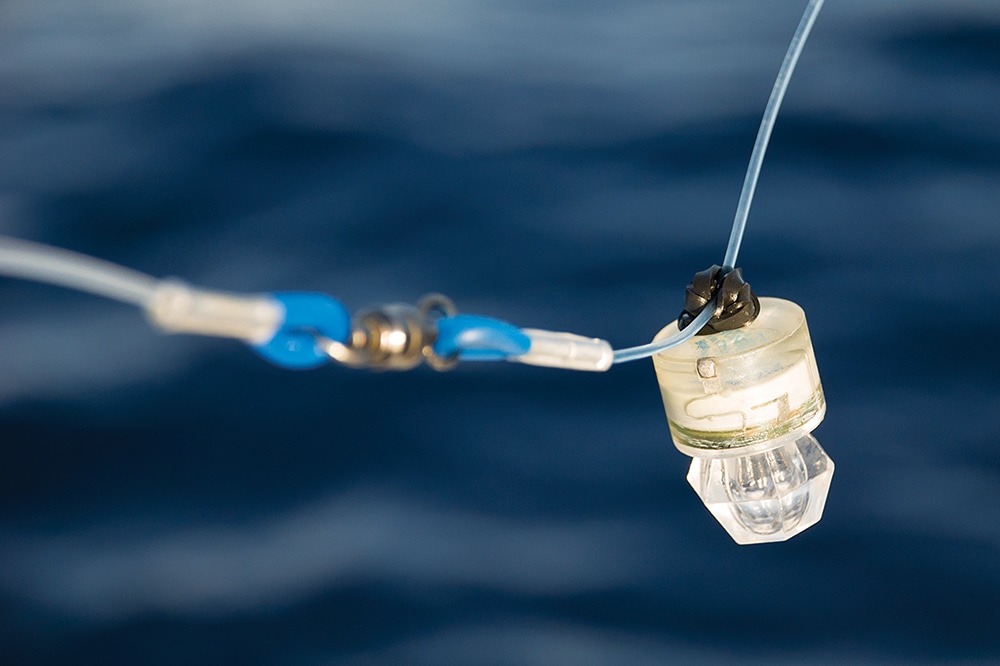
These differences in gear, it seems, often reflect individual anglers’ preferences. “It all comes down to a long leader, longer in stronger current, plus a couple of lights, a durable bait that swims without spinning, and some way to get down to the bottom,” says Capt. Nick Stanczyk, of Bud N’ Mary’s Fishing Marina in Islamorada, Florida. His father, Richard, and uncle Scott brought their first swordfish up from the depths off the Florida Keys in 2003, having been inspired by boats in the mid-1990s in Venezuela that were dropping baits to the bottom of La Guaira Bank using bags of rocks as weights. “We had daytime swordfishing to ourselves for a while, but people knew we were bringing in fish. R.J. [Boyle] was obsessed with figuring it out, just like my dad,” Stanczyk says. Nick uses a variation of his father’s technique — breakaway concrete weights fished on conventional 80-pound-class reels — for charter anglers who want to hand-crank fish. When charter guests prefer electric reels, he uses a rig similar to Boyle’s.
Locating Fish in Three Dimensions
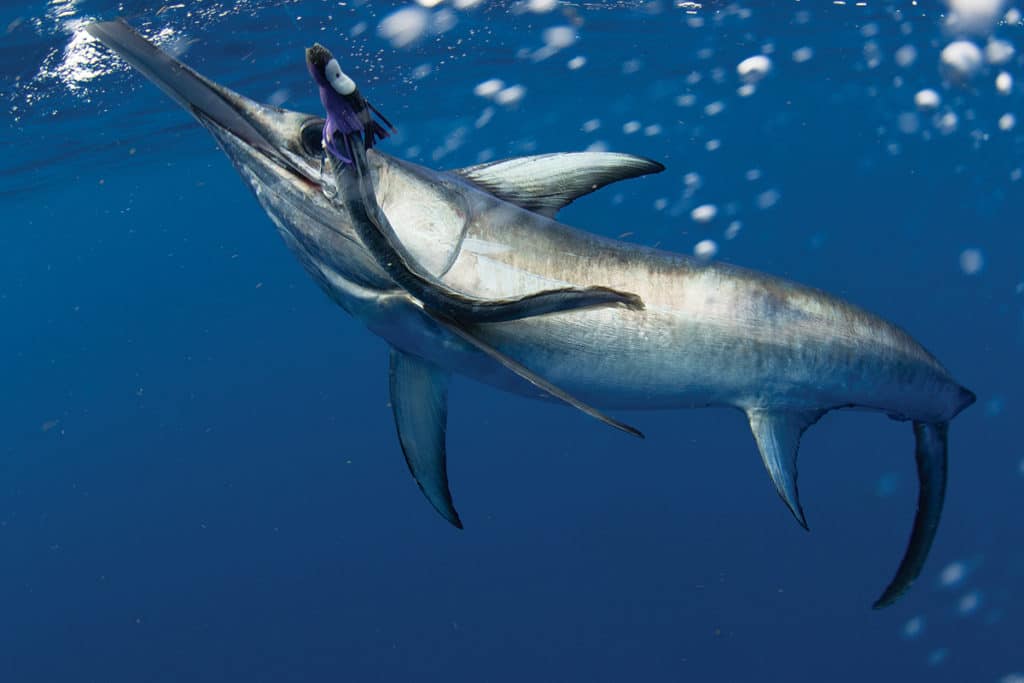
The newest frontier in daytime swordfishing lies within the wholly uncharted depths between the surface and the seafloor. Even in the strong Gulf Stream current, where conventional wisdom holds that swordfish will be near the bottom to avoid the strongest current, swordfish bite 500 feet or more above the seafloor. “In light-current areas, they’re anywhere in the entire water column,” Boyle says. He views thermoclines the way most anglers understand temperature breaks on the surface, knowing fish congregate along those temperature and water‑clarity boundaries.
“As guys up north advance to fishing two or three rods at different depths, we’ll start to see big numbers and big fish,” Boyle says. And not just swords, either. Bigeye and bluefin tuna occasionally but consistently bite bottom‑drifting swordfish baits from Florida through New England.
“It surprises me that swordfishermen aren’t catching more tuna [closer to the bottom],” says Mitch Roffer, president of Roffer’s Ocean Fishing Forecasting Service. “Of all the tuna, bigeye and bluefin like the coldest temperatures, and they tend to swim deeper in the water column, below the thermocline.”
Meanwhile, more than a few blue marlin have eaten swordfish baits as deep as 2,000 feet, and sailfish and white marlin have been caught down to at least 1,200 feet. To fish multiple depths, Boyle lowers one of his typical rigs to 1,500 feet and hangs the line from a pair of commercial fisherman’s 7-by-4-inch marker buoys. “Let fish hook themselves,” he says. The bite is obvious even after Boyle scopes out buoys 100 yards from the boat, then drops his second bait to the bottom. Alternatively, to fight swordfish from conventional reels unencumbered by lead, Boyle uses an electric reel as a downrigger with one Australian-made Diesel release clip about 25 feet above his lead, and sometimes a second clip 150 feet or more above that. He attaches 100-foot leaders to those clips from 80-class reels, setting the clips to release at 15 pounds of pull.
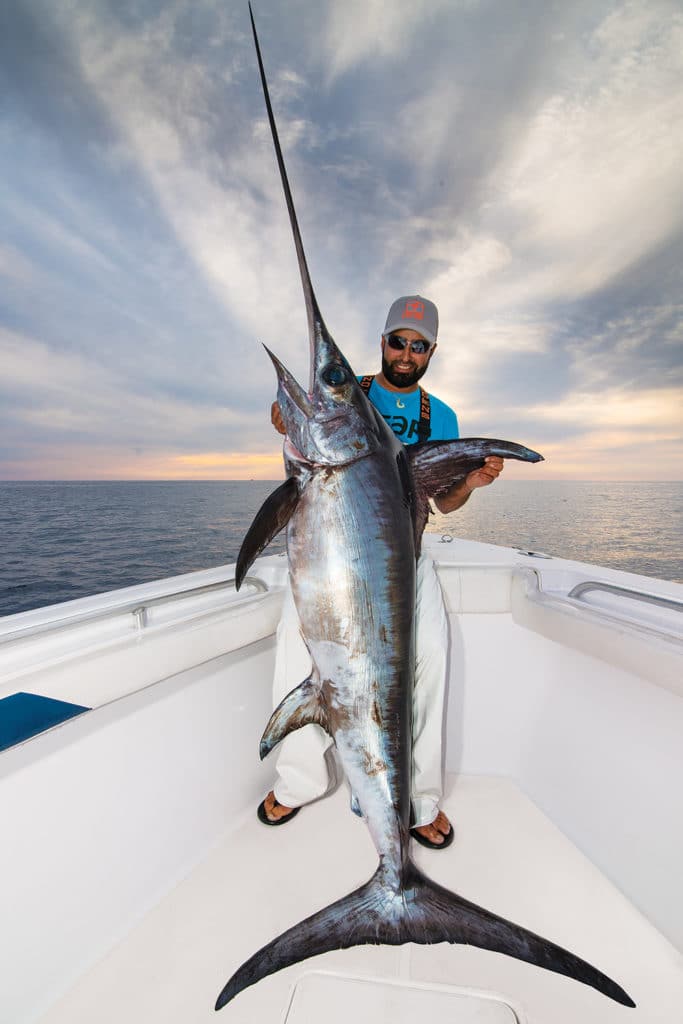
To find areas to fish, Roffer says, “You’re looking for rough bottom, a crater, a canyon wall, an area with pinnacles.” He figures on good fishing in Northeast canyons when the western boundary of a Gulf Stream eddy crosses canyon edges for at least two days. “Swordfish are visual eaters, so you need water clarity, although that could be either blue or blue-green water,” he adds. Swordfish prefer sea-surface temperatures between 55 and 60 degrees off New England, although colder can be OK. For bigeye, ideal SSTs fall between 58 and 61 degrees.
“Swordfish will generally be on the down-current side of a ridge or hill or valley,” DeFusco says, “but I’ve caught them on the up-current side of structure too.” Fishing downhill, where the boat is drifting into deeper water, is somewhat easier. DeFusco says: “I’ve caught them fishing uphill, downhill, on the top of the ridge, down in the hole. Swordfish will be wherever the bait is, and every day is different.”
“A deep-sea fisherman roams the very kingdom of adventure and mystery,” Grey writes in Tales of Swordfish and Tuna, but while he speculates about creatures of the deep, the book barely considers where swordfish go when not on the surface. “How could a hundred years go by, with all these great captains fishing prime swordfish waters, and no one dropped a bait to the bottom?” Boyle asks. “There are more swordfish in the Northeast than off Florida. When the tuna bite shuts off midday, boats are just driving right over the top of them. You’ll catch more fish doing something different from everyone else. You’ve got to think outside the box to grow a new fishery.”
Boyle is now experimenting with deep baits off Santa Catalina Island, where Grey was among the first five Tuna Club of Avalon members to catch a broadbill a century ago. (Grey credits William Boschen, a fellow Tuna Club angler, with the first-ever swordfish caught on rod and reel in 1913.) Given the differences in the West Coast offshore environment and the abundance of tuna and marlin among the Channel Islands, it will be interesting to see what knowledge Boyle brings up from those dark depths.
DeFusco’s Daytime Swordfish Rig
